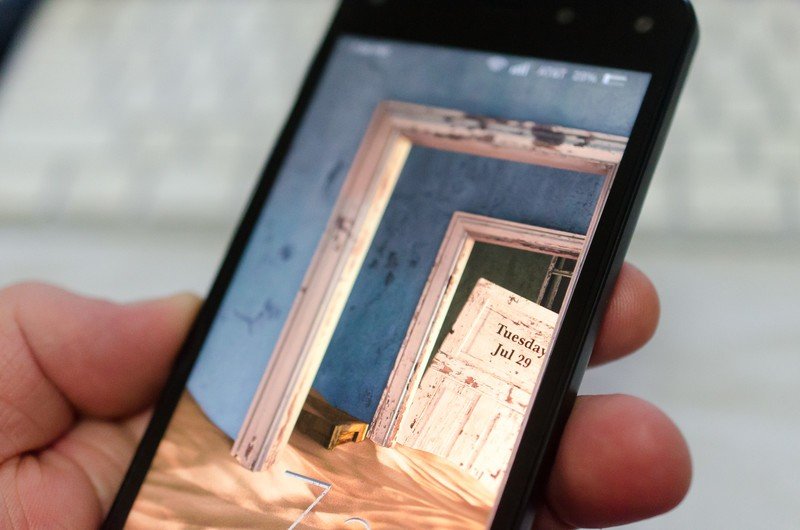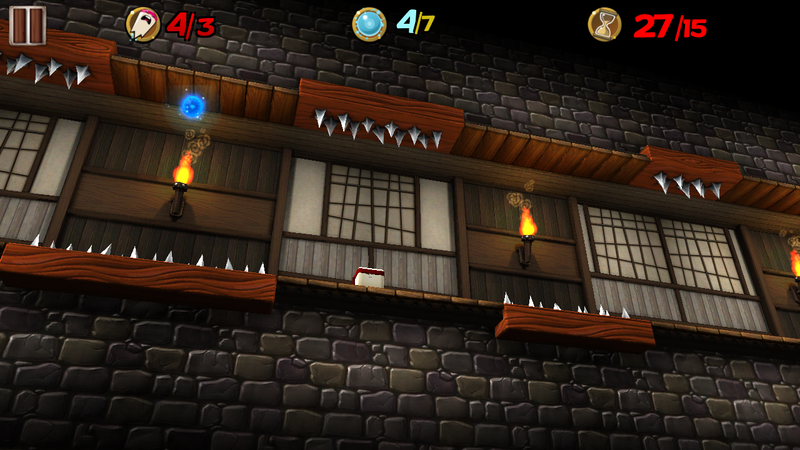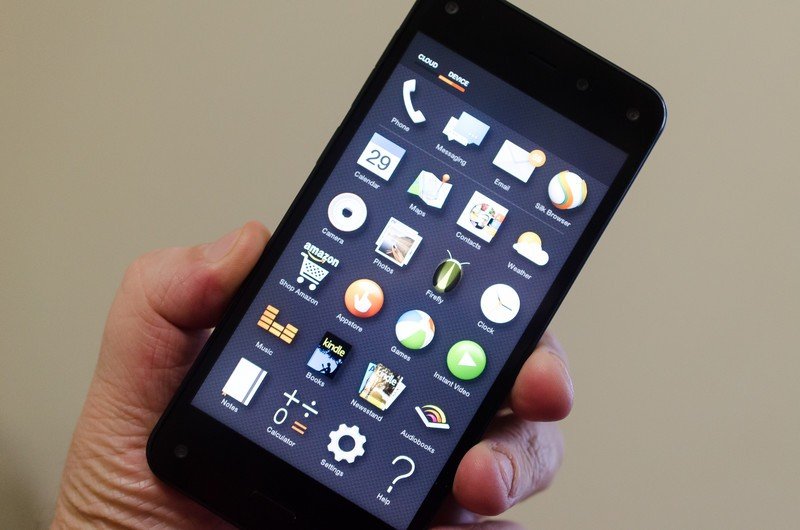The Amazon Fire Phone review

The best phone you probably won't want to buy
Of course we got interested when Amazon finally showed off the Fire Phone. Rumors had been flying for quite a while, but once we actually saw what Amazon had to offer, we had to take a look at it. It's Android at it's core — though not in a way we're used to seeing — and that's what we do here.
So is the Fire Phone more than Amazon Prime in your hands? With features like Dynamic Perspective and an a very custom user interface — and a complete lack of all Google services — the Fire Phone has it's work cut out.
Let's see what makes this thing tick.
Design and hardware
At first glance, the Fire Phone looks just like a mash-up of the iPhone 4S and the Nexus 4. You have a glass back and rubber outer "bumper" with all your controls and ports, with two security screws and drilled holes for the speaker at the bottom. It's a sturdy design and feels well-built, though we know glass-back phones don't go over well with everyone.

While it's not really a looker — there is nothing in the design that says "WOW" — as mentioned it does feel solid. The bumper is actually a stainless steel frame coated with a rubberized finish to make things more "grippable". The power, camera and volume buttons are a black finish stainless, and both front and back are Gorilla Glass 3. The 4.7-inch display is probably smaller than the screen on the phone you're using now, but it is nice and clear at 720p and 315 ppi. Amazon lists the screen brightness at 590 cd/m2, which is a bunch of numbers that translate into bright enough to easily use outdoors in full sun.

Internally, things are running on the capable Snapdragon 800 and 2GB of RAM. You've got either 32GB or 64GB internal storage models to choose from, and both of them are an AT&T exclusive for the time being. All things considered, you're presented with a tidy and well-built package, even though there is nothing in the design or construction that stands out.
Full specifications
Be an expert in 5 minutes
Get the latest news from Android Central, your trusted companion in the world of Android
| Category | Features |
|---|---|
| Size | 5.5" x 2.6" x 0.35" (139.2mm x 66.5mm x 8.9mm) |
| Weight | 5.64 ounces (160 grams) |
| Processor | 2.2GHz Quad-core Snapdragon 800 CPU, with Adreno 330 GPU and 2GB of RAM |
| Display | 4.7" HD LCD display, with 1280 x 720 resolution at 315 ppi, 590 cd/m2 brightness (typical), 1000:1 contrast ratio (typical) |
| Cameras | 13 MP rear-facing camera, multi-frame HDR, auto focus, optical image stabilization, f/2.0 5-element wide aperture lens, LED flash2.1 MP front-facing camera |
| OS | Fire OS 3.5.0 |
| Storage | 32 GB or 64 GB |
| Cloud Storage | Free cloud storage for all Amazon content, and photos taken with Fire phone |
| Battery | Battery size: 2400mAh. Talk time: up to 22 hours; standby time: up to 285 hours. Video playback: up to 11 hours; audio playback: up to 65 hours. |
| Video recording | 1080p HD video recording at 30 fps (front- and rear-facing cameras) |
| Audio playback | Dual stereo speakers with Dolby Digital Plus audio processing |
| TV and Video | Supports screen mirroring and Second Screen |
| Content formats supported | Audio: Dolby Digital (AC-3), Dolby Digital Plus (E-AC-3), non-DRM AAC, MP3, MIDI, OGG, PCM/WAVE, AAC LC/ELD, HE-AAC (v1 & v2), AMR-NB, AMR-WB, AMR-WB+, Audible Enhanced format (AAX); Video: MPEG4, VP8, H.264/MPEG4/AVC,MPEG4 SP, H.263,AVI,HDCP2.x, PlayReady DRM; Images: JPG, GIF, PNG, BMP, GIF87a,GIF89a; Viewable docs: PDF, unprotected MOBI, PRC natively, DOC, DOCX, Kindle (AZW), KF8, TXT |
| Sensors | Dynamic Perspective sensor system with invisible infrared illumination, gyroscope, accelerometer, magnetometer, barometer, proximity sensor, ambient light sensor |
| Location | GPS, Assisted GPS, GLONASS, Wi-Fi/Cellular location, and Digital compass |
| Cellular | UMTS/HSPA+/DC-HSDPA (850, 900, 1700/2100, 1900, 2100 MHz), Quad-band GSM/EDGE (850, 900, 1800, 1900 MHz), 9 bands of LTE (Bands 1, 2, 3, 4, 5, 7, 8, 17, 20), supports carrier aggregation |
| Connectivity | 802.11a/b/g/n/ac Wi-Fi, up to 300 Mbps with channel bonding; Bluetooth 3.0 wireless technology; NFC enabled |
| Headphones | Premium, tangle-free headphones with remote and mic |
| Rating for hearing aids | M4, T4 |
| SIM Card | Pre-installed Nano SIM card |
| Ports | Micro USB 2.03.5mm headphone |
| Warranty and Service | 1-year Limited Warranty included. Use of Fire phone is subject to these terms |
| Included in the Box | Amazon Fire Phone with Fire OS 3.5.0Premium headphones with remote and micMicro USB to USB charging cableUSB power adapter (5W)Quick Start Guide |
Dynamic Perspective

One of the more interestings about the Fire Phone is what Amazon is calling Dynamic Perspective. You have five cameras on the face of the phone, and while one is a fairly standard 2.1MP front facing camera, the other four are wide-angle cameras that are specially designed to use very little power. Each camera is paired up with an infrared LED to track the movements of your face.

The cameras use that 120-degree field of view and IR illumination to follow your facial movement so that the user interface can appear to be three-dimensional. Only two cameras need to see your face at a time for it all to work, and there is plenty of software going on to take all the input and deliver something that is very cool, even if it's not always practical.
To be clear — this is nothing like the HTC EVO 3D or the LG Optimus 3D. Nothing looks like it is coming out of the screen towards you. Think of it as a way to create layers of depth in the interface, where UI elements not only move from side to side or up and down as you tilt the phone, but can overlap each other. It works, and it works well. Seeing some of the lockscreen wallpapers Amazon uses in all their Dynamic Perspective glory is a nice visual treat.

While Amazon uses Dynamic Perspective in many areas of the UI, they are bullish that third-party developers will get on board and tap into it's potential with apps and games. Playing games that use the feature, like To-Fu Fury (a really fun time-waster from Amazon Studios), use head movement and tilting the phone to expose more of the play area and do things like peek around corners. Developers can also use Dynamic Perspective in the carousel to add a little motion effect. It's not subtle, not extremely useful, but it is pretty unique and seems fairly bug free.


The software
Amazon has taken Fire OS from the Kindle Fire tablets and worked it onto a smartphone. It's actually done very nicely, but if you're not used to just how things work there is a small learning curve to do more than the basics you're presented with. At it's heart, it is running atop Android 4.2.2, though you would never know by looking.

The main component of the interface is what Amazon calls the carousel. It's a circular launcher, where you can pin apps, and your recent applications appear. You swipe through it horizontally, or use gestures and motion to shuffle things around. You have a left and right panel with more information that might get lost in the main view, and in practice it works well with one hand on a small screen.

You can also swipe up from the four icons permanently docked at the bottom of the screen to open all of your apps, or swipe up from the bottom to return home from any screen. Swiping down will open the notification panel, which is hidden along with the entire status bar.
While looking through the apps you'll notice the complete lack of anything from Google. Google Play, and all asscoiated services aren't present on the Fire Phone. This is just like the Kindle tablets, so nobody should be surprised. Instead, you have full access to everything Amazon. This includes the Silk browser in lieu of Chrome, the Kindle platform instead of Google Play Books, and full access to Amazon Instant video. The latter are handy to use with the complementary year of Amazon Prime that comes with your purchase.

A unique feature to the Fire Phone is Firefly. Amazon would like nothing more than to make it easy for you to buy from them, and this includes "real" goods as well as digital goods. If you think of the phone as a portal to all things Amazon, Firefly is the easy way for you to find what Amazon hopes you'll buy from them.

While reading barcodes or recognizing a box to shuffle you off to the corresponding item at Amazon is a key function of Firefly, it can also do useful things like scan business cards or signs, then names, emails, URLs and phone numbers are turned into actionable links. Firefly can also identify music or movies and TV shows via buttons atop of the interface. Once it's found what you're watching or listening to, you're whisked to a screen where you can buy it from Amazon as well as share it with a friend.

The Camera
Amazon has packed a 13MP camera with optical image stabilization and an f/2.0 lens into the Fire Phone. The hardware is capable of 1080p video recording, and Amazon touts it as an all around excellent camera. You'll also have unlimited cloud storage for your pictures direct from Amazon.

We're not going to argue. With good (but not great) software and features like HDR, burst mode and a dedicated camera button, the camera certainly is capable and will turn out a great picture provided the person taking it is also capable. Here are a few samples, which are on par with any other great smartphone camera out there.






Give it enough light, and the colors are accurate, there appears to be plenty of detail and a noticeable lack of graininess. It even does fairly well using the LED flash. There's not a lot more to say here — the camera on the Fire Phone is as good as any current Android "flagship" and it won't be a reason to not buy the phone.
The bottom line

There is absolutely nothing wrong with Amazon's Fire Phone. You have a basic design that is built solidly out of good materials, software that's speedy and well-optimized for the device, and interesting new features that don't seem to affect the operation of the phone in any negative way.
The "phone" part of the phone works well, as does Bluetooth, GPS and Wifi. Battery life was average, and the Fire Phone will last most users a full day unless they go crazy with the camera or Firefly. There is nothing that sticks out as a glaring issue that would cause me enough concern to advise against buying the Fire Phone.
But I won't be using it, and it's not the phone's fault.
The lack of Google services just kills it for anyone deeply entrenched into all things Google, and while the alternatives are fine, they aren't the same. I have no Google Photos or Google Drive to back up my pictures and videos, no quick access to Google Docs for all my work-related "stuff" and while Google has done a good job building out mobile interfaces to all their services, it's not the same. I need to know when Phil wants something on Google Hangouts, or when any of you have something cool to share with me on Google+. I've a feeling plenty of people will feel the same, and for an Android fan the Fire Phone is a non-starter in a great little package.

Jerry is an amateur woodworker and struggling shade tree mechanic. There's nothing he can't take apart, but many things he can't reassemble. You'll find him writing and speaking his loud opinion on Android Central and occasionally on Threads.
